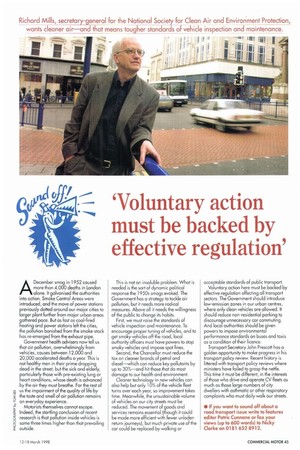Richard Mills, secretary-general for the National Society for Clean Air
Page 47

If you've noticed an error in this article please click here to report it so we can fix it.
and Environment Protection, wants cleaner air—and that means tougher standards of vehicle inspection and maintenance.
'Voluntary action must be backed by effective regulation'
ADecember smog in 1952 caused more than 4,000 deaths in London alone. It galvanised the authorities into action. Smoke Control Areas were introduced, and the move of power stations previously dotted around our major cities to larger plant further from major urban areas gathered pace. But as fast as cool-fired heating and power stations left the cities, the pollution banished from the smoke-stack has re-emerged from the exhaust pipe.
Government health advisers now tell us that air pollution, overwhelmingly from vehicles, causes between 12,000 and 20,000 accelerated deaths a year. This is not healthy men in their prime dropping dead in the street, but the sick and elderly, particularly those with pre-existing lung or heart conditions, whose death is advanced by the air they must breathe. For the rest of us the impairment of the quality of life by the taste and smell of air pollution remains an everyday experience. Motorists themselves cannot escape. Indeed, the startling conclusion of recent research is that pollution inside vehicles is some three times higher than that prevailing outside. This is not an insoluble problem. What is needed is the sort of dynamic political response the 1950s smogs evoked. The Government has a strategy to tackle air pollution, but it needs more radical measures. Above all it needs the willingness of the public to change its habits. First, we must raise the standards of vehicle inspection and maintenance. To encourage proper tuning or vehicles, and to get smoky vehicles off the road, local authority officers must have powers to stop smoky vehicles and impose spot fines. Second, the Chancellor must reduce the tax on cleaner brands of petrol and diesel—which can reduce key pollutants by up to 30%—and hit those that do most damage to our health and environment. Cleaner technology in new vehicles can also help but only 10% of the vehicle fleet turns over each year, so improvement takes time. Meanwhile, the unsustainable volume of vehicles on our city streets must be reduced. The movement of goods and services remains essential (though it could be made more efficient with fewer unladen return journeys), but much private use of the car could be replaced by walking or acceptable standards of public transport. Voluntary action here must be backed by effective regulation affecting all transport sectors. The Government should introduce low-emission zones in our urban centres, where only clean vehicles are allowed. It should reduce non-residential parking to discourage unnecessary car commuting. And local authorities should be given powers to impose environmental performance standards on buses and taxis as a condition of their licence.
Transport Secretary John Prescott has a golden opportunity to make progress in his transport policy review. Recent history is littered with transport policy reviews where ministers have failed to grasp the nettle. This time it must be different, in the interests of those who drive and operate CV fleets as much as those large numbers of city dwellers with asthmatic or other respiratory complaints who must daily walk our streets.
• If you want to sound off about a road transport issue write to features editor Patric Cunnone or fax your views (up to 600 words) to Nicky Clarke on 0181 652 8912.








































































































